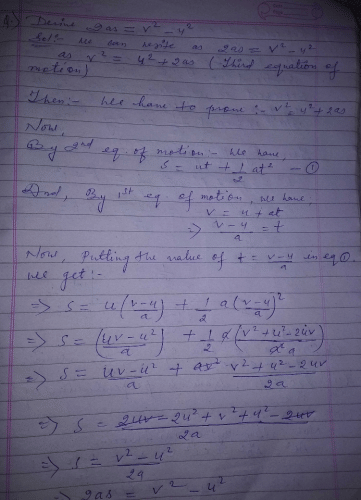Class 9 Exam > Class 9 Questions > Derive 2as=v square-u square?
Start Learning for Free
Derive 2as=v square-u square?
Community Answer
Derive 2as=v square-u square?
Derivation of 2as = v^2 - u^2
To derive the equation 2as = v^2 - u^2, where "a" represents acceleration, "s" represents displacement, "v" represents final velocity, and "u" represents initial velocity, we can start by using the kinematic equations of motion.
Initial Equation:
The initial equation we will use is:
v^2 = u^2 + 2as
Understanding the Variables:
Before proceeding with the derivation, it is important to understand the meaning of each variable in the equation:
- "v" (final velocity) represents the velocity of an object at the end of its motion.
- "u" (initial velocity) represents the velocity of an object at the beginning of its motion.
- "a" (acceleration) represents the rate at which the object's velocity changes.
- "s" (displacement) represents the change in position of the object.
Derivation:
1. Start with the initial equation: v^2 = u^2 + 2as.
2. Rearrange the equation by subtracting u^2 from both sides: v^2 - u^2 = 2as.
3. Divide both sides of the equation by 2: (v^2 - u^2) / 2 = as.
4. Multiply both sides of the equation by 2: 2as = v^2 - u^2.
Conclusion:
By following the steps above, we have derived the equation 2as = v^2 - u^2 from the initial kinematic equation v^2 = u^2 + 2as. This equation relates the final velocity, initial velocity, acceleration, and displacement of an object. It is a useful tool in solving various problems in physics and understanding the motion of objects.
To derive the equation 2as = v^2 - u^2, where "a" represents acceleration, "s" represents displacement, "v" represents final velocity, and "u" represents initial velocity, we can start by using the kinematic equations of motion.
Initial Equation:
The initial equation we will use is:
v^2 = u^2 + 2as
Understanding the Variables:
Before proceeding with the derivation, it is important to understand the meaning of each variable in the equation:
- "v" (final velocity) represents the velocity of an object at the end of its motion.
- "u" (initial velocity) represents the velocity of an object at the beginning of its motion.
- "a" (acceleration) represents the rate at which the object's velocity changes.
- "s" (displacement) represents the change in position of the object.
Derivation:
1. Start with the initial equation: v^2 = u^2 + 2as.
2. Rearrange the equation by subtracting u^2 from both sides: v^2 - u^2 = 2as.
3. Divide both sides of the equation by 2: (v^2 - u^2) / 2 = as.
4. Multiply both sides of the equation by 2: 2as = v^2 - u^2.
Conclusion:
By following the steps above, we have derived the equation 2as = v^2 - u^2 from the initial kinematic equation v^2 = u^2 + 2as. This equation relates the final velocity, initial velocity, acceleration, and displacement of an object. It is a useful tool in solving various problems in physics and understanding the motion of objects.

|
Explore Courses for Class 9 exam
|

|
Question Description
Derive 2as=v square-u square? for Class 9 2025 is part of Class 9 preparation. The Question and answers have been prepared according to the Class 9 exam syllabus. Information about Derive 2as=v square-u square? covers all topics & solutions for Class 9 2025 Exam. Find important definitions, questions, meanings, examples, exercises and tests below for Derive 2as=v square-u square?.
Derive 2as=v square-u square? for Class 9 2025 is part of Class 9 preparation. The Question and answers have been prepared according to the Class 9 exam syllabus. Information about Derive 2as=v square-u square? covers all topics & solutions for Class 9 2025 Exam. Find important definitions, questions, meanings, examples, exercises and tests below for Derive 2as=v square-u square?.
Solutions for Derive 2as=v square-u square? in English & in Hindi are available as part of our courses for Class 9.
Download more important topics, notes, lectures and mock test series for Class 9 Exam by signing up for free.
Here you can find the meaning of Derive 2as=v square-u square? defined & explained in the simplest way possible. Besides giving the explanation of
Derive 2as=v square-u square?, a detailed solution for Derive 2as=v square-u square? has been provided alongside types of Derive 2as=v square-u square? theory, EduRev gives you an
ample number of questions to practice Derive 2as=v square-u square? tests, examples and also practice Class 9 tests.

|
Explore Courses for Class 9 exam
|

|
Signup for Free!
Signup to see your scores go up within 7 days! Learn & Practice with 1000+ FREE Notes, Videos & Tests.
























